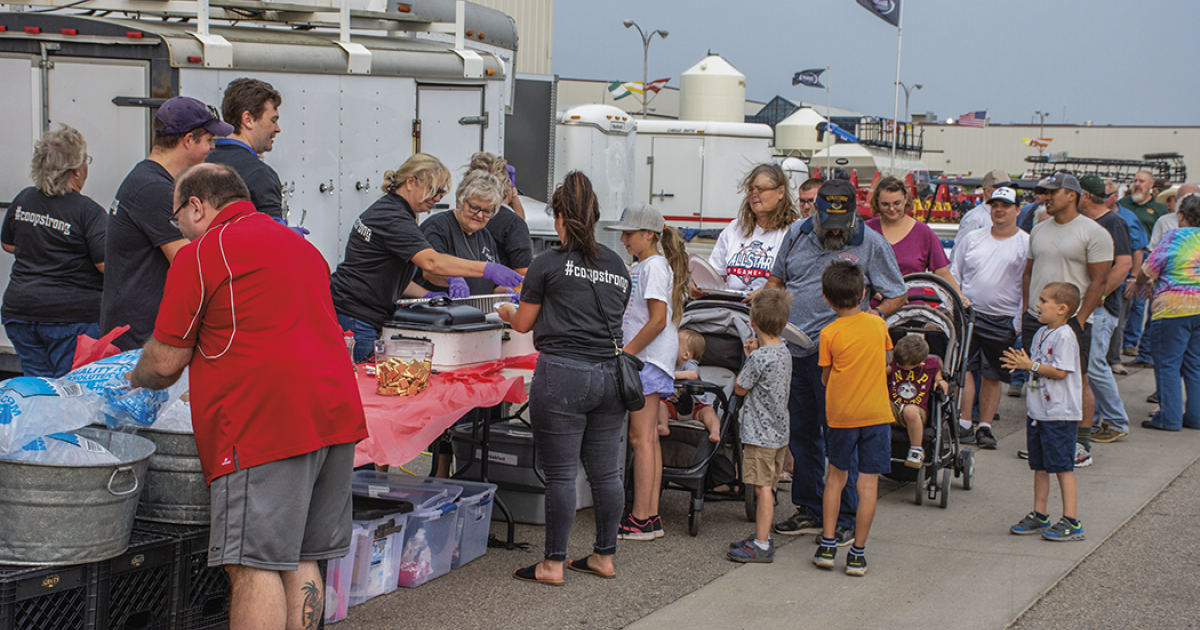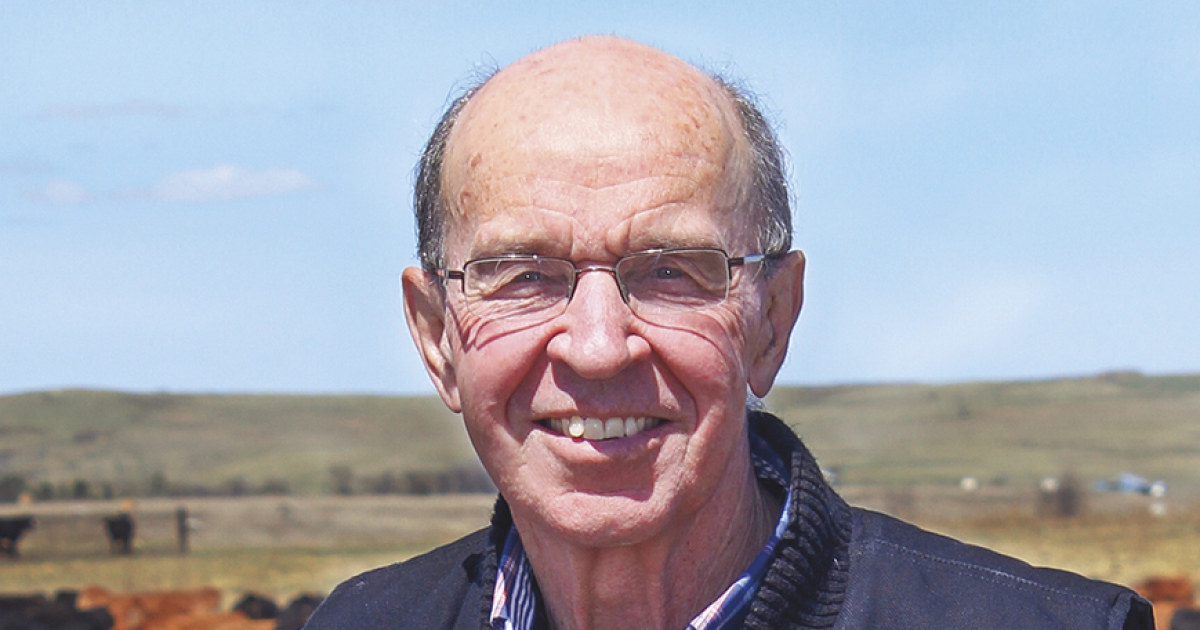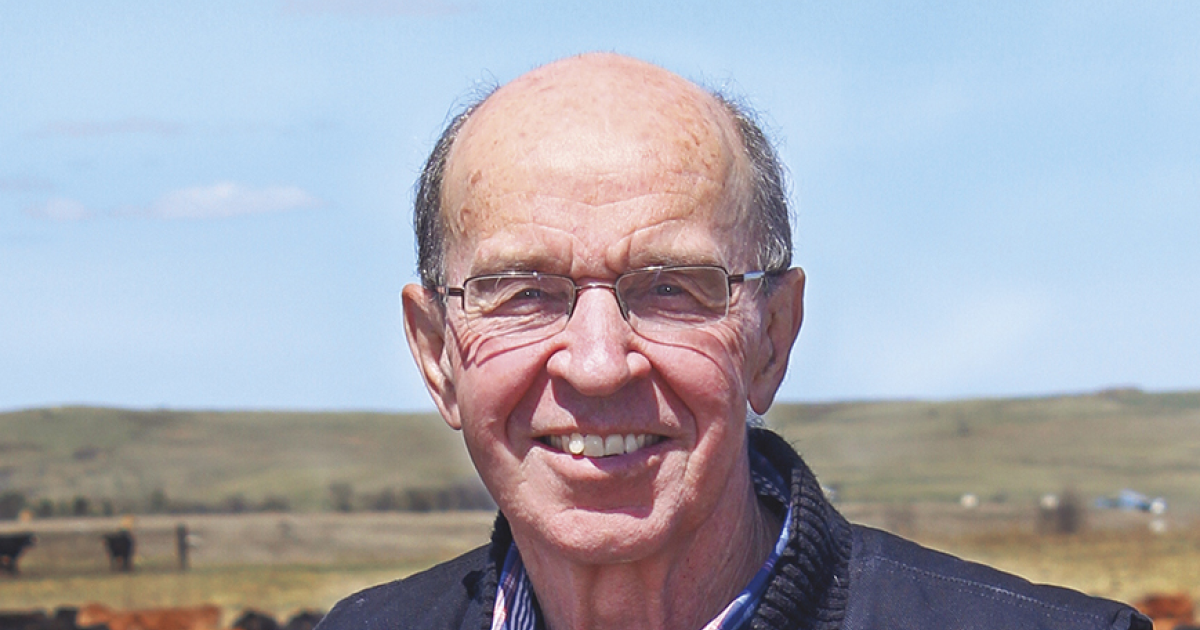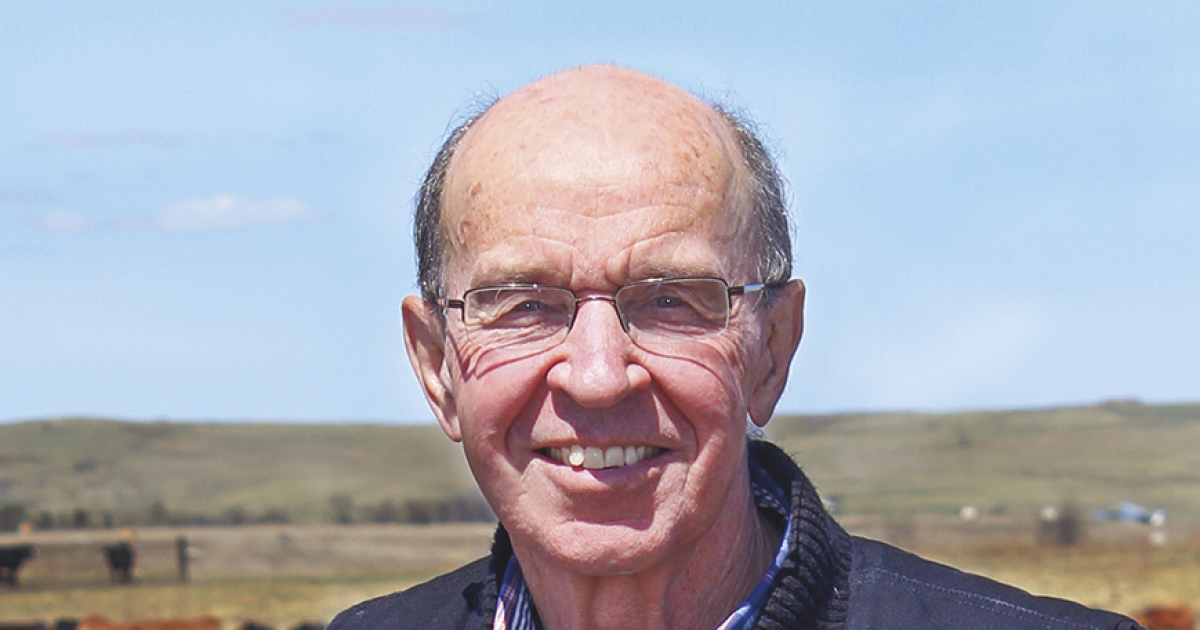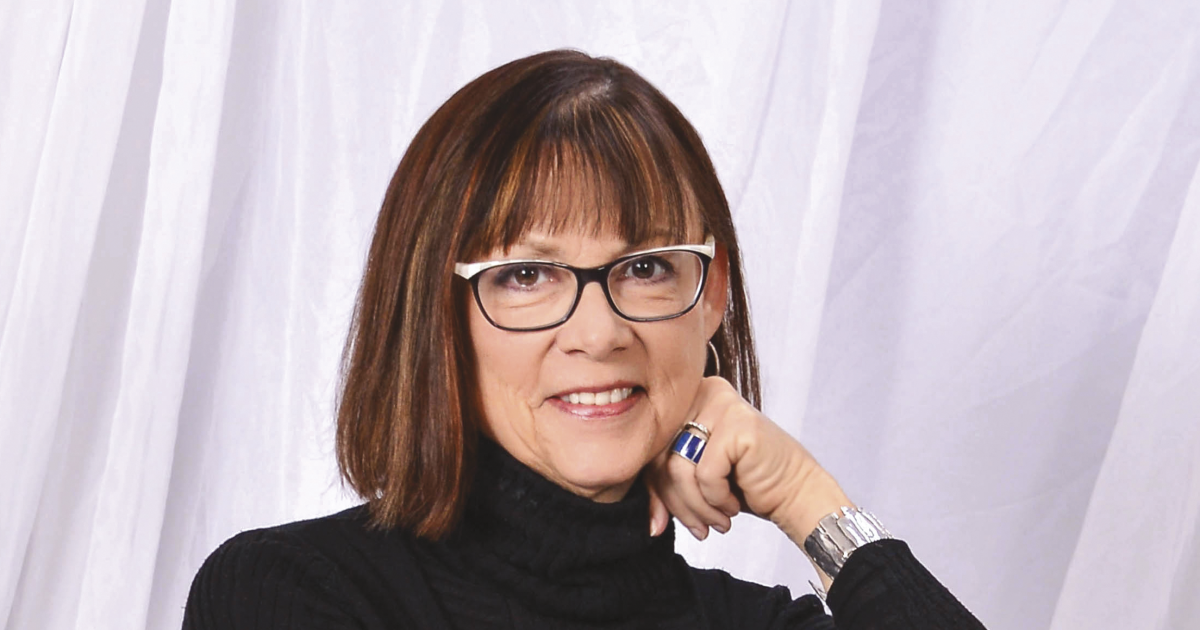A free pancake and sausage breakfast is served to co-op members and attendees of KX/Co-op Day at the state fair.
 It’s National Co-op Month! A chance to celebrate cooperatives and the rich cooperative history that has helped build and support North Dakota communities for generations.
It’s National Co-op Month! A chance to celebrate cooperatives and the rich cooperative history that has helped build and support North Dakota communities for generations.
The cooperative difference. What is it and why is it important? Understanding the cooperative principles is key to defining “the cooperative difference.”
While cooperatives operate in many industries and sectors of the economy, seven cooperative principles set them apart from other businesses: voluntary and open membership; democratic member control; members’ economic participation; autonomy and independence; education, training and information; cooperation among cooperatives; and concern for community.
Navigating through the seven cooperative principles on these pages, one will find examples of local electric cooperatives demonstrating each principle in practice. These core principles laid the foundation for North Dakota’s electric cooperatives and continue to guide them today.
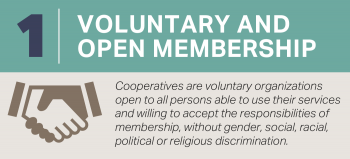 DIVERSITY
DIVERSITY
North Dakota’s electric cooperatives are diverse. Cooperatives serve both residential and commercial areas. Members live on farms, and others are urban apartment dwellers. Some were born in North Dakota, while others weren’t even born in the United States.
Cooperative diversity can be attributed in part to the open membership tenet. The only qualifier of membership is that one accepts the responsibilities that come with it. All persons, regardless of gender, race, religion, political affiliation or social identifiers, are welcome to engage in their cooperative.
In his final year as president of the National Rural Electric Cooperative Association (NRECA), of which North Dakota’s electric cooperatives belong, Curtis Wynn made diversity, equity and inclusion (DEI) at electric co-ops a priority.
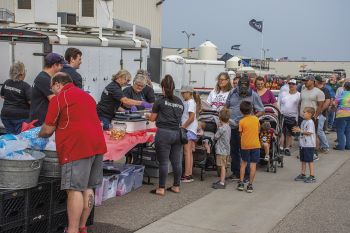
“Co-ops have an economic purpose that is absolutely fundamental to who we are, but we also have a social purpose,” Wynn says. “Years ago, that social purpose was to bring electricity for a better quality of life.”
The cooperative difference can help guide co-ops in ensuring an equitable industry transformation, whether that involves removing barriers so all members can benefit or finding workers knowledgeable of new technologies, Wynn says.
“That’s why the cooperative difference continues to be so important. … We include everyone to improve quality of life and economic opportunity,” he says. “It’s our job, as co-ops and purpose-driven organizations, to nourish each of our diverse members with equity, providing the programs, products and services they need so our entire community can flourish.
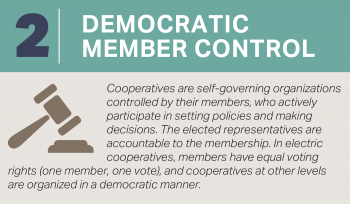 MEMBER RESOLUTIONS PROCESS
MEMBER RESOLUTIONS PROCESS
Member control was at the heart of the modern cooperative movement, which began in 1844 in Rochdale, England. These cooperative pioneers insisted all members have the right to vote. And still today, one member’s voice is just as important as the next, and each member is allowed an equal vote in cooperative matters.
Electric cooperatives maintain member resolutions that are created and refined during an annual cycle that gives members an opportunity to participate at every step. Resolutions approved by membership provide guidance and direction to the cooperative and identify policy or advocacy emphasis.
Typically, a committee of electric co-op members spearheads the resolutions process. They craft the resolutions, then submit them to the membership at the annual meeting. There, members engage in open debate and dialogue, suggest changes or additions to resolutions, or propose other resolutions from the floor. Members then exercise their cooperative voting rights and approve or deny the proposed resolutions.
“As electric cooperatives face legislative and regulatory challenges, member participation in the resolutions process becomes even more essential for the electric cooperative network,” says Deon Vilhauer, who chairs the resolutions committee for the North Dakota Association of Rural Electric Cooperatives (NDAREC) as a Capital Electric Cooperative board member. “Having a voice and a say in how the cooperative shapes its policies, or what it advocates for on our behalf as its members, is one of the distinguishing characteristics of cooperatives – and one worth preserving. Participation is both a responsibility and benefit of co-op membership.”
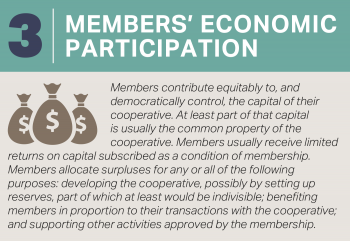 CAPITAL CREDITS
CAPITAL CREDITS
As member-owned organizations, electric cooperatives share their financial success through allocations called capital credits. At the close of each fiscal year, cooperative revenue received in excess of expenses – or margins – is allocated back to members as capital credits.
“At the end of the year, when the cooperative’s operating margins have been finalized, the cooperative will assign each member their portion of the operating margins based on the percentage of their purchases to the total purchases of all members during that year. This is called an allocation,” says Christel Laskowski, business manager for Verendrye Electric Cooperative. Laskowski says a member’s allocation represents his/her equity in the cooperative, which is returned to the member in the form of a capital credit check (cash).
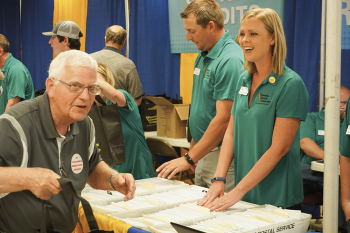
$550,309,140
The total amount of capital credit retirements North Dakota’s electric cooperatives have returned to members, from the start of operations through 2020!
When a cooperative pays out that member equity, it is considered a retirement of capital credits. Each electric cooperative board determines whether or how much capital credits will be returned to members annually, based on the cooperative’s financial condition and other business factors, Laskowski says.
North Dakota’s electric cooperatives have returned a total of $550,309,140 to their members in capital credits, from the start of operations through 2020. To help members during the pandemic, $101,413,061 in capital credits were returned to North Dakota electric cooperative members in 2020 alone.
Laskowski says it’s fun to see the smiles on members’ faces when they’re given a capital credit check for their patronage.
“For the people and businesses new to the co-op, who do not understand what a cooperative is, it’s an opportunity for us to educate them about how we are different than an investor-owned company,” she says.
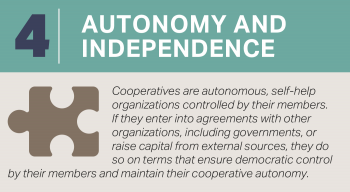 DEMOCRATICALLY ELECTED BOARD OF DIRECTORS
DEMOCRATICALLY ELECTED BOARD OF DIRECTORS
Self-governance is a defining aspect of cooperatives. Member-owners vote to elect fellow consumer-members to represent them as directors on their cooperative boards. Board members are local consumers, who get their power from the local co-op, just like the members they are elected to represent.
Democratically elected board directors provide governance and develop policies that connect the needs and desires of membership to cooperative management and the greater organization. The board is accountable to the membership for managing the business fairly and carefully.
Board members live in the communities they represent, understand the needs of their neighbors, and ultimately strengthen the link between the cooperative and each member, from the beginning to the end of the line. Connie Bitz, a member of Dakota Valley Electric Cooperative (DVEC), serves on electric cooperative boards at the local and state levels.
“Co-ops are in my blood. My grandparents were the first James Valley Electric Cooperative (now DVEC) members to receive electricity. The stories I heard of how life changed on the prairie were amazing,” she says. “Growing up, my family attended all the electric cooperative annual meetings. There was this ‘pride feeling’ in me when I saw how many members’ lives were improved by rural electric cooperatives and understood their importance in our rural economy. I set a goal: When my children were through high school, it would be my turn to advocate for rural electric cooperatives!”
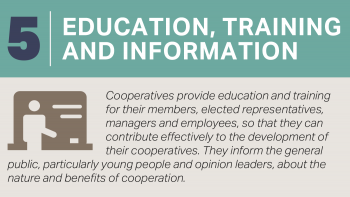 DIRECTOR EDUCATION AND TRAINING PROGRAMS
DIRECTOR EDUCATION AND TRAINING PROGRAMS
America’s network of over 900 electric cooperatives share a commitment to providing education, training and information to its members and employees. Through the national electric cooperative association, NRECA, electric cooperatives participate in a robust and comprehensive education and training program.
NRECA’s Director Certificate Programs are specifically designed to help electric cooperative directors, at every stage of their service, understand their roles and responsibilities, stay up-to-date on key issues and trends in the industry and prepare them to meet the challenges facing electric cooperatives now and in the future. The Director Certificate Programs are offered in three parts, taken in progression from fundamental to advanced: the Credentialed Cooperative Director (CCD) Certificate, the Board Leadership Certificate (BLC) and Director Gold Credential.
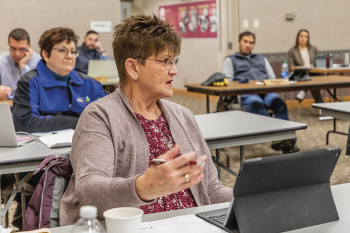
NDAREC, the statewide association for North Dakota’s electric cooperatives, plans and coordinates in-person director education and training courses throughout the year to assist board directors in meeting their goals and program requirements. When faced with the onset of the COVID-19 pandemic in 2020, NDAREC retooled NRECA board-governance programs for online delivery.
“North Dakota electric cooperative directors have a history of strong participation in our education and board-governance programs. Currently, 65% of North Dakota electric cooperative directors hold the CCD credential, more than 33% have the BLC and nearly 14% are Director Gold credentialed,” says Pamela Clark-Stein, NDAREC education and member services director. “Those numbers speak to the commitment our directors have to their local electric cooperatives and the members they serve.”
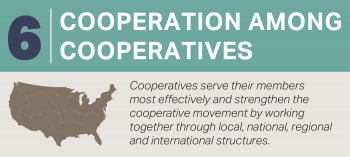 NDAREC
NDAREC
In July 1942, five electric cooperatives – Baker Electric Cooperative, Cass County Electric Cooperative, Nodak Electric Cooperative, Tri-County Electric Cooperative and Verendrye Electric Cooperative – met at a coffee shop in Carrington and, within 30 minutes, formed the North Dakota Association of Rural Electric Cooperatives (NDAREC). By 1958, the NDAREC board of directors filed the association’s articles of incorporation.
Today, NDAREC works with the state’s electric cooperative network to provide a complete package of services, including government relations, legislative advocacy, communications and the publishing of the North Dakota Living magazine, safety training and professional, economic and cooperative development. By pooling their resources and investing in a statewide trade association, electric cooperatives save time and money, while strengthening their collective voice on a statewide level.
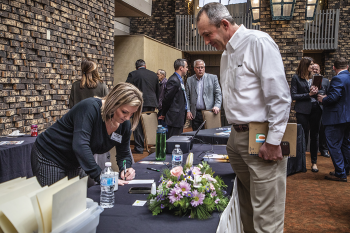
“As the trade association that represents electric cooperatives, the services we provide save cooperatives time, money and resources, and improves quality, which in turn also benefits cooperative members,” says Josh Kramer, NDAREC executive vice president and general manager. “The originators also realized that electric cooperatives needed a unified voice and political clout in order to effectively advocate on behalf of cooperative members and our industry.”
NDAREC’s vision is “an indispensable network of member cooperatives that enriches the lives of their consumers and the communities in which they live.” The association currently represents 16 distribution cooperatives and five generation and transmission cooperatives in North Dakota.
“All our services advance the cooperative mission at the local, state and national levels,” Kramer says.
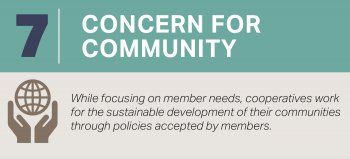 COVID-19
COVID-19
While no cooperative principle is more or less important than the others, “the cooperative difference” shines through in the seventh cooperative principle, concern for community. Electric cooperatives demonstrate concern for member needs and the communities they serve in many ways. Clear examples can be seen by simply turning the page back a year, when the coronavirus arrived in North Dakota, disrupting lives, livelihoods and communities.
Burke-Divide Electric Cooperative distributed 1,500 individual hand sanitizers to schools in its service area.
Cass County Electric Cooperative donated more than 1,000 N-95 masks to local health care workers.
Lower Yellowstone Rural Electric Cooperative held a book, game and food drive and donated the items to senior living facilities, Meals on Wheels program recipients, preschools and daycares.
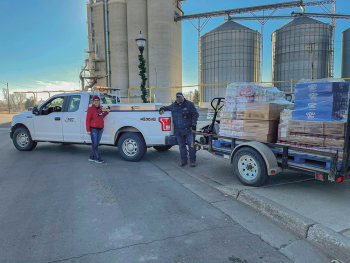
McLean Electric Cooperative delivered three pallets of donated food to the local food pantry.
Northern Plains Electric Cooperative waived late fees for three months and worked with members to establish payment plans. The cooperative also purchased gift cards from local businesses and hosted a member giveaway to thank their members, businesses and communities.
Verendrye Electric Cooperative donated $1,250 in gift cards to the Minot Area Homeless Coalition and Men’s Winter Refuge, fed 100 nurses free lunch at a local Mexican restaurant and gave employees and members gift cards to disburse to community members during the holidays as a way to say thanks or offer support.
These examples provide a mere snapshot of the difference cooperatives make in their communities. And collectively, the seven cooperative principles provide the roadmap for electric cooperatives – and will continue to light the path to a brighter, more prosperous future.
Cally Peterson is editor of North Dakota Living. She can be reached at cpeterson@ndarec.com.


